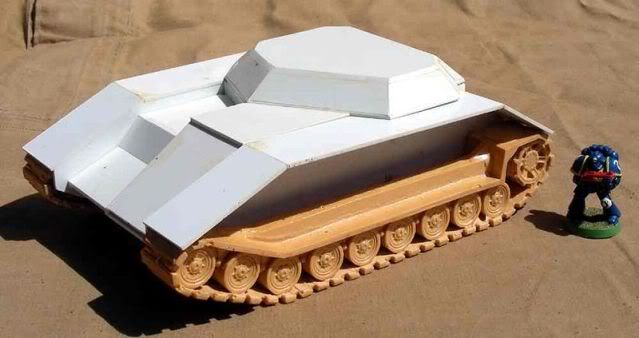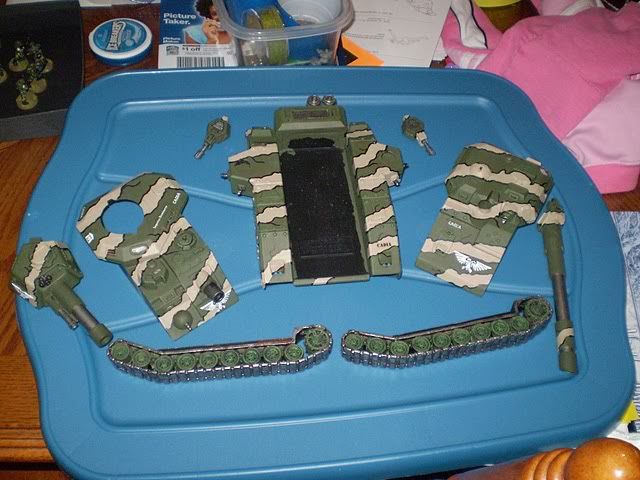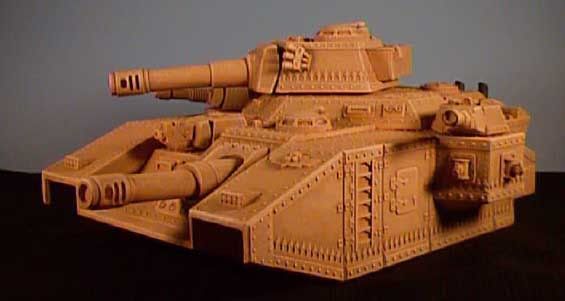The Baneblade first trundled into the Warhammer 40k universe in the Epic game system as the Glaive (Baneblade), along with its sister tank the Falchion (Stormsword) in January of 1990. Later that same year it would appear in White Dwarf 132, December 1990 (pg 47-56), as a construction project complete with templates, by Tony Cottrell (who now runs Forgeworld). Also included in this article was a data sheet for using the Baneblade in games of Warhammer 40,000 with acompanying damage chart and weapon effects.
(Picture from WD 132 - build from cardboard)
In this article, the first of what can be considered offical Games Workshop Baneblade cannon, Tony Cottrell states: "The Baneblade is one of the Imperial Guards most formidable vehicles - a huge tank armed with two battlecannon, three lascannon and seven heavy bolters." The Demolisher cannon would not appear until July of 1995 in White Dwarf 187 with the addition of the Demolisher tank to the Imperial Guard motorpool, so the original Baneblade carried two battlecannons.
The first Baneblade production prototype of a Mike Biasi Studios Baneblade circa 1991, this photograph is courtesy of Tim DuPertuis, editor of Inquisitor Magazine. Mike Biasi used this mock up to get his first Games Workshop License to produce Baneblade models with his company 'Mike Biasi Studios'. Tim DuPertuis and Mike Biasi would later found Armorcast together in 1995.
These first resin Baneblade kits were created as modular tank kits allowing the Shadowsword and Baneblade variants to be interchangeable by swapping out the hull and carriage portions.
Super detail Baneblade kits contained more detail, such as the ladders on the sides and exhaust ports on the battle cannon muzzle brake, than other Baneblade kits produced at the same time.
Around 1999 Games Workshop did not renew the license for Armorcast, opting to move the responsibility for production of resin kits to a new start up company, Forgeworld. Forgeworld would start producing models less than a year later with Games Workshop licences and Armorcast stopped producing their gaming line to begin working on terrain products that same year.
Next Monday, the 14th, we will take a look at the last chapter of Baneblade history following the production of the Baneblade by Forgeworld and later Games Workshop in a plastic kit.
Cheers,
Tallarn





awesome story, great idea, wish I could find one of those baneblades. I am putting you on for my pick at the top ten! Maybe you can write in this post when the follow up will come.
ReplyDeleteMike
Santa Cruz Warhammer
Thanks Mike, I am glad you like it! The second part of the Baneblade history will be on Monday the 14th, it covers the history once Forgeworld produced their first Baneblade model in 2002.
ReplyDeleteNice history! Being a relative newb to the 40k scene I didn't know any of this- good stuff!
ReplyDeleteYeah, I fell in love with the Baneblade in early 90s Epic, and just had to buy the FW one in about 2002/3 when I could scrape the beans together. Nearly a decade on it's almost finished...and I've fielded it twice!
ReplyDeleteOne small correction:to "Tim DuPertuis and Mike Biasi would later found Armorcast together in 1995." Tim DuPertuis and David Garton founded Armorcast. Mike was always and independent contractor, although we worked very closely together.
ReplyDelete